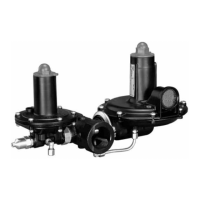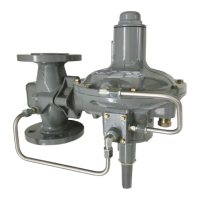Introduction
Parameter
x.00
Parameter
description format
Keypad and
display
Serial
communications
CT Modbus
RTU
PLC Ladder
programming
CTSoft Menu 0
Advanced parameter
descriptions
Menu 4
Commander SK Advanced User Guide 67
Issue Number: 9 www.controltechniques.com
This parameter can be changed from OFF(0) to On(1) when the drive is still running, the drive does not have to be disabled or stopped etc.
When torque control is enabled, slip compensation is automatically disabled to prevent overspeed trips (O.SPd)
See Pr 4.14 for details.
These parameters control the proportional and integral gains of the current controller. As already mentioned the current controller either provides
current limits or closed loop torque control by modifying the drive output frequency. The control loop is also used in its torque mode during mains loss,
or when the controlled mode standard ramp is active and the drive is decelerating, to regulate the flow of current into the drive. Although the default
settings have been chosen to give suitable gains for less demanding applications it may be necessary for the user to adjust the performance of the
controller. The following is a guide to setting the gains for different applications.
Current limit operation
The current limits will normally operate with an integral term only, particularly below the point where field weakening begins. The proportional term is
inherent in the loop. The integral term must be increased enough to counter the effect of the ramp which is still active even in current limit. For
example, if the drive is operating at constant frequency and is overloaded the current limit system will try to reduce the output frequency to reduce the
load. At the same time the ramp will try to increase the frequency back up to the demand level. If the integral gain is increased too far the first signs of
instability will occur when operating around the point where field weakening begins. These oscillations can be reduced by increasing the proportional
gain. A system has been included to prevent regulation because of the opposite actions of the ramps and the current limit. This can reduce the actual
level that the current limit becomes active by 12.5%. This still allows the current to increase up to the current limit set by the user. However the current
limit flag (Pr 10.09) could become active up to 12.5% below the current limit depending on the ramp rate used.
Torque control
Again the controller will normally operate with an integral term only, particularly below the point where field weakening begins. The first signs of
instability will appear around rated speed, and can be reduced by increasing the proportional gain. The controller can be less stable in torque control
mode rather than when it is used for current limiting. This is because load helps to stabilise the controller, and under torque control the drive may
operate with light load. Under current limit the drive is often under heavy load unless the current limits are set at a low level.
Mains loss and controlled standard ramp
The DC bus voltage controller becomes active if mains loss detection is enabled and the drive supply is lost or controlled standard ramp is being used
and the machine is regenerating. The DC bus controller attempts to hold the DC bus voltage at a fixed level by controlling the flow of current from the
drive inverter into its DC bus capacitors. The output of the DC bus controller is a current demand which is fed into the current PI controller as shown
below:
4.12 Unused parameter
4.13 Current controller Kp gain
Coding
Bit SP FI DE Txt VM DP ND RA NC NV PT US RW BU PS
111
Range 0 to 250
Default 20
Update rate Background
4.14 Current controller Ki gain
Coding
Bit SP FI DE Txt VM DP ND RA NC NV PT US RW BU PS
111
Range 0 to 250
Default 40
Update rate Background
P Pr
4.13
I Pr
4.14
Current
demand
Active
current
Frequency
reference
+
-

